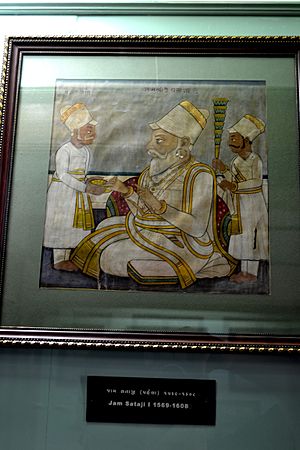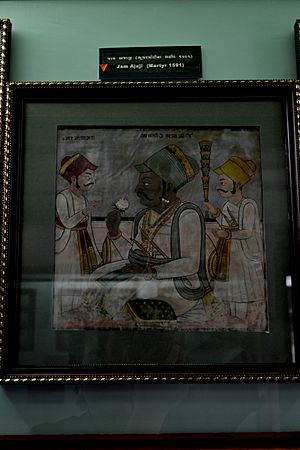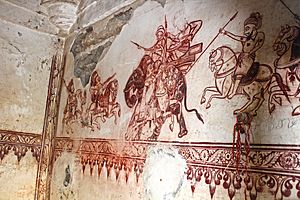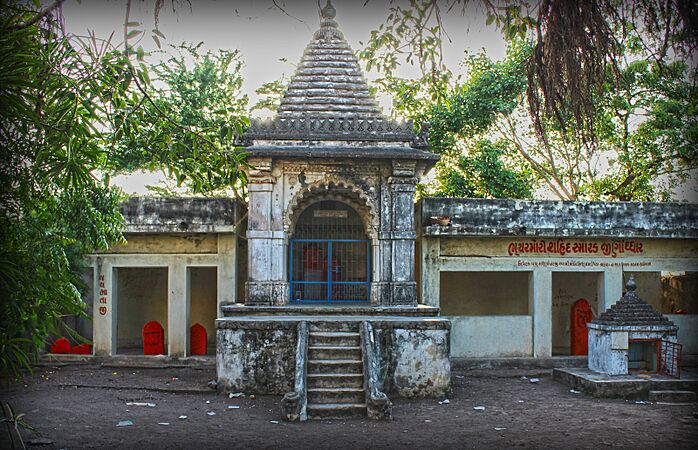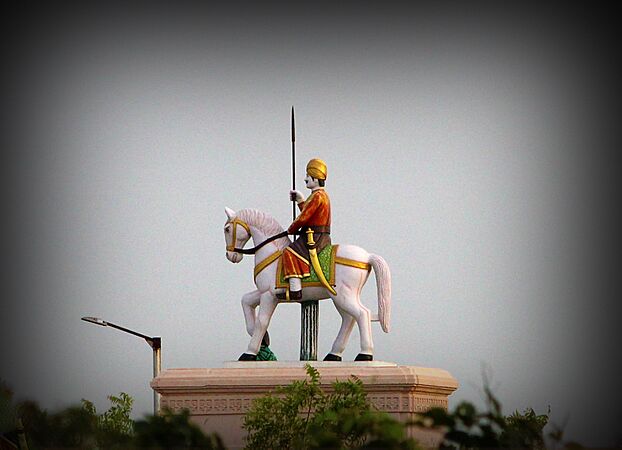Battle of Bhuchar Mori facts for kids
Quick facts for kids Battle of Bhuchar Mori |
|||||||||
|---|---|---|---|---|---|---|---|---|---|
| Part of Akbar's conquest of Gujarat | |||||||||
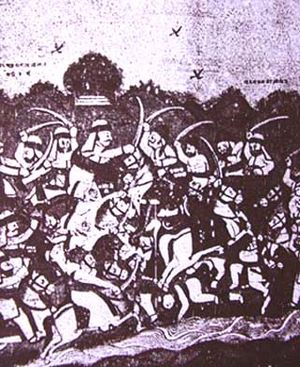 Sketch from the Yaduvanshprakash by Mavdanji Ratnu, 1934 |
|||||||||
|
|||||||||
| Belligerents | |||||||||
Junagadh State |
Gujarat Sultanate Nawanagar State Cutch State Muli State |
||||||||
| Commanders and leaders | |||||||||
Daulat Khan Ghori Loma Kuman |
Muzaffar Shah III Jam Sataji Jam Ajaji † Jasa Vajir † Rao Bharmalji I Sanganji Vadher Vasaji Parmar |
||||||||
| Strength | |||||||||
|
|
||||||||
| Casualties and losses | |||||||||
|
|
||||||||
| The numbers are derived from agreement of various sources. | |||||||||
The Battle of Bhuchar Mori, also known as the Battle of Dhrol, was a major fight in July 1591. It happened on the Bhuchar Mori plateau near Dhrol in Gujarat, India. This battle was between the army of Kathiawar, led by Nawanagar State, and the powerful Mughal army.
The main reason for the battle was to protect Muzaffar Shah III. He was the last ruler, or Sultan, of the Gujarat Sultanate. Muzaffar Shah had escaped from the Mughal emperor Akbar and found safety with Jam Sataji of Nawanagar. The Kathiawar army included soldiers from Junagadh and Kundla. However, these groups later joined the Mughal side. The battle was very costly, with many people losing their lives on both sides. In the end, the Mughal army won.
Many people consider this the biggest battle in the history of the Saurashtra region. It is sometimes called the Panipat of Saurashtra.
Why the Battle Happened
The Gujarat Sultanate's Troubles
Muzaffar Shah III was the Sultan of the Gujarat Sultanate, but he was not a strong ruler. Different powerful nobles managed the state, and they often fought among themselves. Muzaffar Shah tried to take control of Ahmedabad with the help of other nobles.
Akbar's Conquest
A noble named Itimad Khan, who was in charge of Ahmedabad, invited the Mughal emperor Akbar to take over the state. Akbar entered Ahmedabad easily in November 1572. He captured Muzaffar Shah, who was hiding. By 1573, Akbar had slowly taken control of the entire state. His governors ruled Gujarat, but there were often rebellions.
Muzaffar Shah's Escape and Return
Muzaffar Shah was jailed in Agra, but he managed to escape in 1583. He returned to Gujarat and gathered about 700 soldiers. He received help from Jam Sataji of Nawanagar, Daulat Khan of Junagadh, and Khengar of Sorath. Together, they built a large army of 30,000 cavalry (horse soldiers) and 20,000 infantry (foot soldiers).
Muzaffar Shah attacked villages near Ahmedabad and later captured Ahmedabad, Vadodara, and Bharuch. However, he was defeated by the new Mughal governor, Mirza Khan, in January 1584. Muzaffar Shah fled from place to place. When no one else would help him, Jam Sataji of Nawanagar offered him a safe place in the Barda Hills.
Mughal Demands and Jam Sataji's Stand
In 1588, Emperor Akbar sent his foster brother, Mirza Aziz Koka, to Gujarat to capture Muzaffar Shah. Mirza Aziz Koka had a large army. He asked Jam Sataji to hand over Muzaffar Shah. But Jam Sataji refused, saying it was his duty as a Kshatriya (a warrior class) to protect someone who sought his help. Jam Sataji's forces also bothered the Mughal army by cutting off their supplies and taking their horses and elephants.
The Battle Begins
Mirza Aziz Koka gathered his Mughal army near Dhrol. This army had between 8,900 and 9,000 warriors from many different places, including Roman, Arab, Russian, and Turkic soldiers.
The Kathiawar army was also near Dhrol, with 17,000 to 21,000 warriors. Jam Sataji's forces included many local clans like Jadeja and Sodha. They were joined by Nawab Dolatkhan Ghori and Ra Khengar of Junagadh State, Loma Khuman of Kherdi-Kundla, and soldiers from Rao Bharmalji I of Cutch State. Sanganji Vadher of Okha and Vasaji Parmar of Muli State also brought their armies. Even a group of naked Atit Sadhus (holy men) returning from a pilgrimage joined them. The Kathiawar army also had many cannons, 84 elephants, and many horses and camels.
Early Skirmishes and Betrayal
When the Mughal army reached Bhuchar Mori, Jam Sataji attacked with help from Kutch forces. There were also two night raids on the Mughals. The main battle was delayed for two days because of rain. Several smaller fights happened, and the Kathiawar army won many of them. Jam Sataji's strategies worked well in the rainy season.
After three months, Mirza Aziz Koka started peace talks. He even offered money to Jam Sataji. However, some of Jam Sataji's allies, like Loma Khuman and Daulat Khan of Junagadh, secretly made deals with Mirza Aziz Koka. They had their own reasons for being unhappy with Jam Sataji. Once Mirza Aziz Koka was sure of their support, he declared war again.
The Main Fight
When the battle began, the armies of Junagadh and Kundla left the Kathiawar forces. Jam Sataji realized he had been betrayed. He quickly left the battlefield on a fast horse to protect his state and family. His minister, Jasa Vajir, and his son Jasaji continued fighting until evening. They also made sure Jam Sataji's family was safe by sending them away on ships.
The battle lasted for about nine hours. Between 26,000 and 30,000 soldiers were fighting. There were many deaths on both sides. Cannons, horses, elephants, and camels were all used in the fight.
Jam Sataji's son, Kunwar Ajaji III, was in town for his wedding celebration. When he heard about the battle, he rushed to the battlefield with over 500 Rajput warriors from his wedding party.
Fierce Combat and Losses
The next day, the Mughal army attacked. Kunwar Ajaji, Jasa Vajir, and Mehramanji Dungarani led the Nawanagar army. Both sides began firing cannons. The fighting was intense.
Kunwar Ajaji, riding a horse, bravely attacked Mirza Aziz Koka, who was on an elephant. Ajaji used a spear, but Mirza Aziz Koka was not hurt. Mughal soldiers then attacked Ajaji, and he died on the battlefield. Many other brave leaders from Nawanagar, including Jasa Vajir, Mehramanji, and Nag Vajir, also died. About 2,000 Kathiawar soldiers were killed.
The Mughal forces also suffered heavy losses. Their generals, Mohammed Rafi, Saiyad Saifuddin, and others, died. It is believed that more than 10,000 soldiers from both sides died in total. Over a thousand Atit Sadhus also lost their lives. Jam Sataji lost 67 relatives, including his son, nephew, and son-in-law. The 14 sons of Mehramanji also died. About 700 Nawanagar horses were injured.
When the Battle Ended
According to records from Nawanagar, the battle ended on Wednesday, July 1591. This day was a festival called Shitla Satam. Other historical writings also confirm this date.
After the Battle
Nawanagar's Fate
After their victory, the Mughal army marched towards Nawanagar. Jam Sataji had already told his queens to leave the town by ship from the port. Surajkunwarba, Ajaji's newly married wife, heard about his death. She went to the battlefield and, following an old tradition, honored her husband's memory by joining him on his funeral pyre.
Mirza Aziz Koka reached Nawanagar and looted it. Jam Sataji went to Junagadh to protect Muzaffar Shah. Daulat Khan, who was wounded, died later in Junagadh. The Mughal army went to Junagadh but returned to Ahmedabad because they were tired from the long campaign.
The End of Muzaffar Shah
In 1592, Mirza Aziz Koka returned to Kathiawar with new forces. He surrounded Junagadh, and the fort surrendered after three months. Muzaffar Shah had already fled to the Barda hills. The Mughal army left a governor in Junagadh and then conquered other places like Prabhas Patan and Dwarka.
Muzaffar Shah later went to Okha Mandal and then to Kutch. He asked Rao Bharamalji I of Kutch for safety. However, Rao Bharamalji knew what had happened to Nawanagar and Junagadh. He handed Muzaffar Shah over to the Mughal troops. While being taken to the Mughal camp, Muzaffar Shah died on December 24, 1592. With his death, the rule of the Muzaffarid dynasty in Gujarat ended.
Jam Sataji's Return
Morbi was given to Rao Bharmalji as a reward for his help. Jam Sataji returned to Nawanagar in 1593. He lived there, but a Mughal deputy helped manage the state. Jam Sataji's second son, Jasaji, was kept in Delhi for some time.
Remembering the Battle
The Battle of Bhuchar Mori is a very important event in the history of Saurashtra. Many folk tales, songs, and historical stories have come from it. Because so many people died, the name Bhuchar Mori became a word for a great loss of life in the Halar region.
Memorial Site
There is a special memorial site on the Bhuchar Mori plateau. It has a shrine with a paliya (memorial stone) for Ajaji. There is also a paliya for his wife, Surajkunwarba. Inside the shrine, there is a 16th-century painting showing Ajaji on his horse attacking Mirza Aziz Koka on an elephant. There are 23 more paliyas inside the compound and 8 outside, honoring other brave soldiers. There are also 8 tombs for Mughal soldiers.
The Government of Gujarat built a new memorial at the site in 2015. A memorial forest, Shaheed Van, was opened in 2016. Every year, people from the Kshatriya community visit the site for prayers on Shitla Satam. A large annual fair is also held there, attracting thousands of visitors.
A Day of Mourning
Because Kunwar Ajaji died on Shraavana Vad 7, or Shitla Satam, the people of Nawanagar and the surrounding Halar region stopped celebrating that day for many years. They mourned for nearly 250 years. Later, when a son was born to Jam Ranmalji on the same day, people slowly started celebrating Shitla Satam again.
In Books and Poems
The battle has inspired many writers. Durso Adho, a poet in Akbar's court, wrote a poem about it. Court poets of Nawanagar also described the event in their works. A famous Gujarati author, Jhaverchand Meghani, wrote a novel called Samarangan in 1938 based on the battle. Another author, Harilal Upadhyay, wrote Ranmedan in 1993, which focused on the events leading up to the battle.


